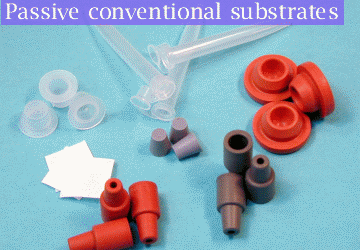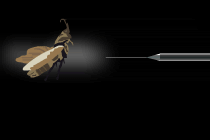THE PIEZOELECTRIC MICRO-SPRAYER
What is the Piezoelectric Micro-Sprayer?
- The Piezoelectric Micro-Sprayer is a new device for releasing semiochemicals or odours that provides significant advantages over passive substrates (i.e. filter paper, rubber septa, etc) for releasing semiochemicals or odours.
- The Piezoelectric Micro-Sprayer allows for precise release of semiochemicals and odours during the entire course of an experiment.
Release rates can be set to almost any value, i.e. pg/min, fg/min, etc. - The Piezoelectric Micro-Sprayer can release any mixture of semiochemicals or odours at constant ratios and rates.
The release rate of semiochemicals or odours is not affected by factors such as the vapor pressures and mole percentages of the compounds, temperature, relative humidity, material surface area, and wind speed. - Can be used in the laboratory and in field experiments.
Multiple Piezoelectric Micro-Sprayers can be used to provide dynamic control over stimulus application.

List of some laboratories that implemented the Piezoelectric Micro-Sprayer in their research:
- USDA ~ APHIS ~ PPQ ~ S&T Otis Laboratorym Buzzards Bay, USA
- Department of Entomology, University of California Riverside, California, USA.
- Max Planck Institute, Chemical Ecology, Jena, Germany.
- USDA/ARS, Illinois, USA.
- USDA/ARS, Wapato, Washington, USA.
- Department of Experimental Ecology. University of Ulm, Ulm, Germany
- East Malling Research, Kent, UK.
- Department of Primary Industry (DPI), Shepparton, Australia.
- Lund University, Chemical Ecology group, Lund, Sweden.
- Swedish University of Agriculture Sciences (SLU), Chemical Ecology group, Alnarp, Sweden.
- Cornell University, Agriculture Experimental Station, Dept. Entomology, Geneva , NY, USA.
- University of Alberta, Dept. of Biology, Edmonton, Canada.
- Agriculture and Agri-Food, Vineland, Canada.
- Agriculture and Agri-Food, Summerland, Canada.
- Pherobank BV, Wijk bij Duurstede, The Netherlands.
- North Dakota State University, Department of Entomology, Fargo, USA.
- Universitat de Lleida, Departament de Producció Vegetal. Lleida, Spain.
- Sterling International Inc, Spokane, USA.
- Istituto Agrario San Michele all’Adige, SafeCrop Center, San Michele all’Adige, Italy.
- Pland and Food Research, Lincoln, New Zealand.

Some recent publications:
- Borrero-Echeverry F, Bengtsson M, Nakamuta K, Witzgall P. 2018. Plant odor and sex pheromone are integral elements of specific mate recognition in an insect herbivore. Evolution. doi: 10.1111/evo.13571.
- Lebreton S, Borrero-Echeverry F, Gonzalez F, Solum M, Wallin E, Hedenström E, Hansson BS, Gustavsson A-L, Bengtsson M, Birgersson G, Walker WB, Dweck H, Becher PG, Witzgall P. 2017. A Drosophila female pheromone elicits species-specific long-range attraction via an olfactory channel with dual specificity for sex and food. BMC Biol 15:88.
- Trona F., Anfora G., Balkenius A., Bengtsson M., Tasin M., Knight A., et al. 2013. Neural coding merges sex and habitat chemosensory signals in an insect herbivore. Proc. R. Soc. B 280:20130267. doi: 10.1098/rspb.2013.0267.
- Faraone N., Errico G.D., Caleca V., De Cristofaro A., Trimble R.M. 2013. Electrophysiological and behavioral responses of oriental fruit moth to the monoterpenoid citral alone and in combination with sex pheromone. Environmental Entomology, 42:314-322.
- Becher, P.G., Bengtsson, M., Hansson, B.S ., Witzgall, P. 2010. Flying the fly: Long-range flight behavior of Drosophila melanogaster to attractive odors. Journal of Chemical Ecology. 36: 599-607.
- Trimble, R. M., and Marshall, D. 2010. Differences in the relationship between sensory adaptation of antennae and concentration of aerial pheromone in the oriental fruit moth and obliquebanded leafroller (Lepidoptera: Tortricidae): Implications for the role of adaptation in sex Pheromone-mediated mating disruption of these species. Environmental Entomology. 39: 625-632.
- Schmidt-Busser D, von Arx M , Guerin PM. 2010. Host plant volatiles serve to increase the response of male European grape berry moths, Eupoecilia ambiguella, to their sex pheromone. Journal of Comparative Physiolology A 195: 853–864
- Girling R.D., and Carde R.T. 2007 Analysis and manipulation of the structure of odor plumes from a piezo-electric release system and measurements of upwind flight of male almond moths, Cadra cautella, to pheromone plumes. Journal of Chemical Ecology.33:1927-1945
More references can be found in this link










